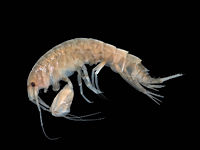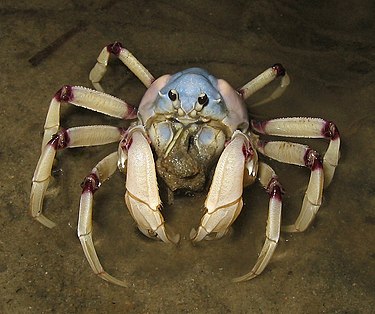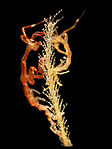Portal:Crustaceans
The Crustaceans Portal Crustaceans are a group of arthropods that are a part of the subphylum Crustacea (/krəˈsteɪʃə/), a large, diverse group of mainly aquatic arthropods including decapods (shrimps, prawns, crabs, lobsters and crayfish), seed shrimp, branchiopods, fish lice, krill, remipedes, isopods, barnacles, copepods, opossum shrimps, amphipods and mantis shrimp. The crustacean group can be treated as a subphylum under the clade Mandibulata. It is now well accepted that the hexapods (insects and entognathans) emerged deep in the Crustacean group, with the completed group referred to as Pancrustacea. The three classes Cephalocarida, Branchiopoda and Remipedia are more closely related to the hexapods than they are to any of the other crustaceans (oligostracans and multicrustaceans). The 67,000 described species range in size from Stygotantulus stocki at 0.1 mm (0.004 in), to the Japanese spider crab with a leg span of up to 3.8 m (12.5 ft) and a mass of 20 kg (44 lb). Like other arthropods, crustaceans have an exoskeleton, which they moult to grow. They are distinguished from other groups of arthropods, such as insects, myriapods and chelicerates, by the possession of biramous (two-parted) limbs, and by their larval forms, such as the nauplius stage of branchiopods and copepods. Most crustaceans are free-living aquatic animals, but some are terrestrial (e.g. woodlice, sandhoppers), some are parasitic (e.g. Rhizocephala, fish lice, tongue worms) and some are sessile (e.g. barnacles). The group has an extensive fossil record, reaching back to the Cambrian. More than 7.9 million tons of crustaceans per year are harvested by fishery or farming for human consumption, consisting mostly of shrimp and prawns. Krill and copepods are not as widely fished, but may be the animals with the greatest biomass on the planet, and form a vital part of the food chain. The scientific study of crustaceans is known as carcinology (alternatively, malacostracology, crustaceology or crustalogy), and a scientist who works in carcinology is a carcinologist. (Full article...) Selected article
Caprella mutica, commonly known as the Japanese skeleton shrimp, is a species of skeleton shrimp. It is a relatively large caprellids, reaching a maximum length of 50 mm (2.0 in). The species is sexually dimorphic, with the males usually being much larger than the females. It is characterised by their "hairy" first and second thoracic segments and the rows of spines on their bodies. Body colour ranges from green to red to blue, depending on the environment. It is an omnivorous, highly adaptable, opportunistic feeder. In turn, it provides a valuable food source for fish, crabs, and other larger predators. C. mutica is usually found in dense colonies attached to submerged man-made structures, floating seaweed, and other organisms.
C. mutica is native to shallow protected bodies of water in the Sea of Japan. In as little as 40 years, it has become an invasive species in the North Atlantic, North Pacific, and along the coasts of New Zealand. It is believed to have been accidentally introduced to these areas through the global maritime traffic and aquaculture. Outside of its native range, C. mutica is often exclusively synanthropic, being found in large numbers in and around areas of human activity. Its ecological and economic impact as an invasive species is unknown, but it poses a serious threat to native populations of skeleton shrimp in the affected areas. Did you know?
Selected biography
Mary J. Rathbun (1860–1943) was an American zoologist, specialising in crustaceans. She was born on June 11, 1860 in Buffalo, New York the youngest of five children. Her mother died when she was only one year old, and Mary was therefore "thrown on her own resources". She was schooled in Buffalo, graduating in 1878, but never attended college. Mary first saw the ocean in 1881 when she accompanied her brother, Richard Rathbun, to Woods Hole, Massachusetts. He was employed as a scientific assistant to Addison Emery Verrill, alongside Verrill's chief assistant, the carcinologist Sidney Irving Smith. Mary helped label, sort and record Smith's specimens, and worked on crustaceans ever since.
For three years, Mary worked on a voluntary basis for her brother, before being granted a clerkship by Spencer Fullerton Baird at the Smithsonian Institution. She continued to work at the museum, largely unaided, and after 28 years, she was promoted to assistant curator in charge of the Division of Crustacea. Her largest work was Les crabes d'eau douce ("Freshwater crabs"), published in three volumes in 1904–1906. She wrote or co-wrote 166 papers in total, including descriptions of 1147 new species and subspecies, 63 new genera, one subfamily, 3 families and a superfamily, as well as other nomenclatural novelties. The taxa first described by Rathbun include important commercial species such as the Atlantic blue crab Callinectes sapidus, and the tanner crab, Chionoecetes bairdi. She retired on the last day of 1914, but did not stop working until her death. She qualified for a Ph.D. at George Washington University in 1917. Selected image Soldier crabs of the genus Mictyris, including M. longicarpus (pictured) congregate at low tide to feed by filtering mud. As the tide rises, they bury themselves, digging in a corkscrew pattern. General imagesThe following are images from various crustacean-related articles on Wikipedia.
Crustacean lists
SubcategoriesRelated portalsWikiProjectsAssociated WikimediaThe following Wikimedia Foundation sister projects provide more on this subject:
Discover Wikipedia using portals
|






















































